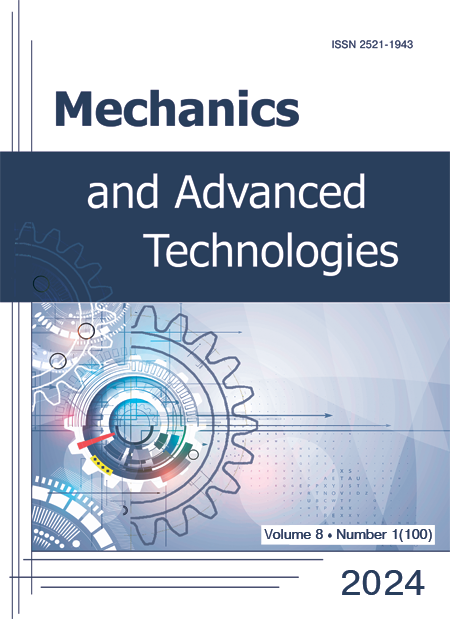The effect of deformation rate on the process of hot extrusion with dispensing of round hollow semi-finished products
DOI:
https://doi.org/10.20535/2521-1943.2024.8.1(100).297296Keywords:
finite element method, hot reverse extrusion, round and square billet, hollow semi-finished product, deformation rate, temperature, forces, stresses, strainsAbstract
Stamping of round hollow semi-finished products by hot reverse extrusion is one of the initial operations in the manufacture of hollow products for special purposes. The force and shape change of the metal during hot plastic forming is significantly affected by the deformation rate or the speed of movement of the deforming tool. For special-purpose products, certain mechanical properties are required in the wall height and bottom part. The wall height properties are ensured at subsequent stretching transitions with thinning of the semi-finished product obtained by hot extrusion, which involves working out the metal structure by plastic deformation to achieve the required properties. Therefore, it is an urgent task to study the effect of the deformation rate on the force and shape change of the metal during hot reverse extrusion of hollow semi-finished products.
To determine the influence of the deformation rate on the parameters of hot reverse extrusion with the dispensing of hollow semi-finished products from round and square billets by means of finite element method (FEM) modeling and to compare the results of theoretical researches.
Theoretical researches of extrusion power modes, specific forces, and the stress-strain state of metal were carried out by modeling using the FEM in the DEFORM software environment.
The FEM was used to model the process of hot reverse extrusion with dispensing of round hollow semi-finished products from mild steel with protrusions at the end of the bottom part on the side of the cavity and on the outer surface. The deformation rate was in the range of 20 to 80 mm/sec. Round and square cross-sectional blanks were used. The dependence of the extrusion force on the punch displacement was determined. The distribution of specific forces on the deforming tool was determined. The stress-strain state and temperature distribution in the deformed metal at the end of extrusion were determined. The development of the metal structure by hot plastic deformation was evaluated and the results obtained were compared
The effect of the deformation rate on the parameters of hot reverse extrusion with dispensing of round hollow semi-finished products was determined.
References
- E. I. Sеmenov Ed., Hot stamping, in Forging and stamping. Handbook, Vol. 2, Moscow: Mechanical Engineering, 1986, 592 р.
- V. Kaliuzhnyi, S. Sytnyk and V. Levchenko, “Comparative analysis of hot reverse extrusion of hollow products from round and square blanks”, Mech. Adv. Technol., vol. 7, no. 2 (98), pp. 236–242, Oct. 2023. DOI: https://doi.org/10.20535/2521-1943.2023.7.2.288484.
- V. N. Danchenko, A. A. Milenin and V. I. Kuzmenko, Computer modeling of metal pressure processing processes. Numerical methods. Dnipropetrovsk: System Technologies, 2008, 448 p.
- V. L. Kalyuzhny, L. I. Aliyeva, I. S. Aliev and V. N. Gornostay, “Hot volumetric stamping of hollow products from high-strength aluminum alloy with specified mechanical properties”, Procurement production, vol. 12, pp. 18–25, 2018.
- X. Hu, R. B. Mei, F. Zhu, Y. Fan, Y. B. Liang, X. B. Wang, D. G. Wang and Z. R. Jing, “Numerical Simulation for Microstructure Evolution in In718 Alloy During Cylindrical Cup Backward Extrusion”, Advanced Materials Research, vol. 650. pp. 92–97, 2013. DOI: https://doi.org/10.4028/www.scientific.net/AMR.650.92.
- P. Szota, S. Mróz, A. Stefanik, K. Laber and R. Mola, “Theoretical and experimental analysis of the backward extrusion process with a rotational die of AZ31 alloy”, Metalurgija, vol. 60, no. 1–2, pр. 36–38, 2021. Available: https://hrcak.srce.hr/clanak/357468
- S. H. Hosseini, K. Abrinia and G. Faraji, “Applicability of a modified backward extrusion process on commercially pure aluminum”, Materials & Design, vol. 65, pp. 521–528, 2015. DOI: https://doi.org/10.1016/j.matdes.2014.09.043.
- S. Kuhnke, V. Sanabria, F. Gensch, R. Nitschke and S. Mueller, “Numerical Investigations on Material Flow During Indirect Extrusion of Copper-Clad Aluminum Rods”, Front. Mater., vol. 7, pp. 1–10, Jun. 2020. DOI: https://doi.org/10.3389/fmats.2020.00157.
- B. B. Alamer, “The Study of Stress State in Indentation of a Flat Punch with Rounded Edge in Axisymmetric Backward Extrusion”, Eng. & Tech. Journal, vol. 31, no. 9, pp. 1765–1778, 2013. DOI: https://doi.org/10.30684/etj.2013.82188.
- Jong-Taek Yeom, Jeoung Han Kim, Jae-Keun Hong, Nho-Kwang Park and Chong Soo Lee, “Prediction of Microstructure Evolution in Hot Backward Extrusion of Ti-6Al-4V Alloy”, Journal of Metallurgy, vol. 2012, no. 6, pp. 1–6, 2012. DOI: https://doi.org/10.1155/2012/989834.
- R. Broomand, A. Babaei, H. Mazloom Bashiri and M. H. Zaheri, “Processing MMC tubes via friction stir backward extrusion”, Kafaran, vol. 19, no. 57, pp. 225–242, 2022. DOI: https://doi.org/10.48301/KSSA.2021.287462.1550. Aviable: https://www.magiran.com/p2477493.
- Duk Jae Yoon, Eung-Zu Kim, Kyoung Hoan Na, Yong-Shin Lee, “A study on the forming characteristics of AZ 31B Mg Alloy in a combined Forward–backward extrusion at warm temperatures”, Applied Sciences, vol. 8, no. 11, p. 2187, 2018. DOI: https://doi.org/10.3390/app8112187.
Downloads
Published
How to Cite
Issue
Section
License
Copyright (c) 2024 Володимир Драгобецький, Олександр Калюжний, Володимир Калюжний, Станіслав Ситник

This work is licensed under a Creative Commons Attribution 4.0 International License.
Authors who publish with this journal agree to the following terms:
- Authors retain copyright and grant the journal right of first publication with the work simultaneously licensed under CC BY 4.0 that allows others to share the work with an acknowledgement of the work's authorship and initial publication in this journal.
- Authors are able to enter into separate, additional contractual arrangements for the non-exclusive distribution of the journal's published version of the work (e.g., post it to an institutional repository or publish it in a book), with an acknowledgement of its initial publication in this journal.
- Authors are permitted and encouraged to post their work online (e.g., in institutional repositories or on their website) prior to and during the submission process, as it can lead to productive exchanges, as well as earlier and greater citation of published work











